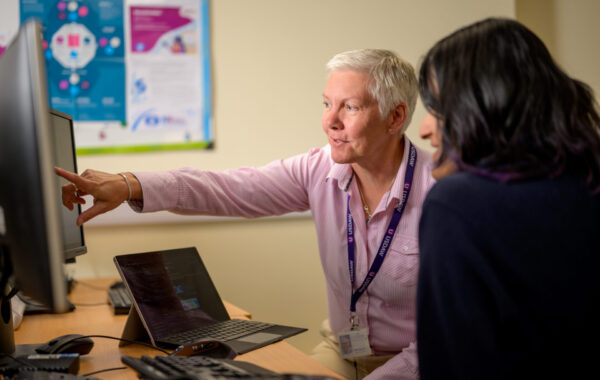by Richard Denyer-Bewick, Operations Director
Here’s an opinion — the Digital by Default agenda is contributing to a loneliness crisis in the UK and digital inclusion is not the remedy for loneliness that I would love it to be.
It’s clear from new research by the BBC[i] that the age group we might consider to be the most digitally included (16–24) are also the group that report feeling lonely more and experience it at a higher level of intensity.
Levels of loneliness are higher in younger people with 40% feeling lonely, compared with only 27% of over 75s
People who feel lonely have more ‘online only’ Facebook friends
Only a third believe that loneliness is about being on your own
This might surprise some people, as we often think of loneliness as something that affects those in later life more and often linked to major life events such as a bereavement or retirement. Yet the study showed that the older we get the less likely we are to feel extremes of loneliness. So, we might also speculate that for the majority of people who experience loneliness, being digitally connected (as more younger people are) does not in itself prevent loneliness.
I would love to be able to say that supplying people with digital technology and enabling them to use it (building motivation, confidence and skills) was a sure-fire way of addressing social isolation and loneliness — but it’s not. Certainly, digital inclusion can help — it can be an enabler or a catalyst — but it’s less likely to resolve these issues on its own. Loneliness and isolation are usually more complicated and multi-faceted issues than can be addressed by a bit of tech and a bit of support to use it.

A loneliness crisis?
We now live in the most digitally connected age our society has ever experienced. We have more online friends, colleagues, chats, discussions, messages and transactions than ever before and there are more mobile phones in the world than there are people[ii].
It could be easy to think that as long as you have access to the internet and a connected device, you’d never need to feel alone! Yet loneliness and isolation are major issues in our society. In fact, being lonely could increase your risk of premature death by 30%[iii] and is considered by some to be as big a health issue in the UK as obesity (or perhaps even bigger)[iv].
It’s hard to say from the evidence whether loneliness is on the rise, but more and more studies are drawing the same conclusions[v]; that loneliness and feelings of isolation are present right across age groups[vi] and are a major contributor to poorer health and wellbeing outcomes for people[vii].
As a digital inclusion organisation, we often say one of the benefits of being online is a possible reduction in loneliness and social isolation. We know that helping people get the skills and confidence to use the internet (and communication apps such as WhatsApp or Skype) can make an enormous difference to people’s lives.
However, we have to remember that digital connection is not a silver bullet for tackling loneliness.
In fact, over-use or even addiction to digital communication[viii] can result in the opposite — it can completely isolate people (whether at work or socially) and actually increase people’s experience of loneliness. It’s likely that this is the case for many younger people who may be at the same time the most connected and experiencing the most loneliness.
I’ve often said that at one end of the spectrum we have digital inclusion and at the other we have digital submersion — a feeling of being completely overwhelmed by the sheer number of connections and communications we experience concurrently through a multitude of social media channels, emails and notifications systems.
I think that if our digital connections multiply at the cost of our face to face ones, we have a big problem and that over reliance and use of technology for communications and transactions exacerbates issues surrounding loneliness.
Digital By Default
There is no doubt that over the last 10 years, public and voluntary services have been pushed and pulled to become ‘digital by default’ — a campaign of digital and social change spearheaded by the Government since 2010[ix]when it initially set out its plans to digitise 25 of its most popular services and create a Digital Service Standard[x].
The often-stated reasons to become Digital By Default are that services can be delivered more efficiently online and cost less to run, acknowledging also that more and more customers now demand an online service — it’s what people want.
Contact centre industry experts know that inbound telephony is decreasing and use of mobile apps is increasing[xi]. Local councils are trying to find innovative solutions to respond to their ever-increasing financial constraints. Often this means the start of a digital transformation programme for the council and increased digital transactions for customers, rather than face to face or telephone contact.
But cheaper transactions come at a social cost. They may be more efficient for a service to deliver, but are they good for our very human need for connection?
When money is taken out of public services, the cost savings arise from having fewer staff in customer facing roles and fewer buildings in which people might have met. Think of all the stories you may have heard over the last few years about services closing down, including council and housing association offices and some of our amazing library services out there, many of which are under consultation for closure or ‘redesign’ because Councils can no longer afford to run them.
As those services, buildings and customer facing employees reduce in number, so do the opportunities for human interaction. When it comes to public and voluntary services, we also need to remember that they are the very ones providing essential contact for those in our communities who are most vulnerable; possibly most isolated and potentially at risk of experiencing loneliness.
Other areas of life are becoming subject to digital disruption and further opportunities for social interactions are reducing. Increasingly we shop online and choose to avoid the high street; we work alone more at our computers with home working on the rise; pubs and community centres are also closing down; people in rural locations struggle to reach places where other people are because the transport networks aren’t commercially viable and community transport services are also feeling the pinch. Many of those deep rural communities also have the poorest connectivity when it comes to the internet and 3G/4G service.
We are losing many of our social safety nets for human connection — Skype, while it can help, simply cannot fill the gap.

This is a serious issue and one that was acknowledged and championed by MP Jo Cox in 2015[xii] who subsequently set up a cross-party commission on loneliness. Her work and legacy are continued and in October 2018 the government launched “A Connected Society: A strategy for tackling loneliness”[xiii].
I, like others in the sector, broadly welcome the strategy — loneliness is an issue of deep importance in our society that needs to be tackled because even though digital is a great enabler, I think it is also contributing to a loneliness crisis on a large scale.
That’s why I was heartened to see that the strategy calls for services to be designed in a human friendly way; so that they increase opportunities for human interaction — from housing developments and planning decisions to transport networks.
Importantly the strategy stresses the need to ensure we are digitally inclusive and do not discriminate against those who may lack the access, skills or confidence needed to maintain connections with society and reduce the risk of loneliness and its harmful effects.
In the Ministerial Foreword the strategy says:
As we continue to make the most of new technologies, ways of working and delivering services, we need to plan for connection and design in moments of human contact… [ensuring] public services [are] designed and run so they consider social relationships, not just efficient transactions.
I think this is an admirable aim and one that Government would do well to remain mindful of as the drive for services to be Digital By Default continues to lead the charge for service transformation at a local level.

END NOTES:
i. Launch of the Loneliness Experiment results (BBC News 01.10.18) |
All In The Mind: The Loneliness Experiment Results (01.10.18 BBC 28 mins) [sound player link] |
The Anatomy of Loneliness Episode 1 focus on Age (02.10.18 BBC 42 mins) [sound player link] |
The Anatomy of Loneliness Episode 2 focus on Social Media (09.10.18 BBC 42 mins) [sound player link]
[^]
ii. The Independent 07.10.2014 “There Are Officially More Mobile Devices Than People In The World” [^]
iii. NHS Behind the headline: Loneliness increases risk of premature death [^]
iv. The Daily Telegraph 06.08.2017 “Loneliness Is Deadlier Than Obesity, Study Suggests” [^]
v. Campaign To End Loneliness — The Facts |
AgeUK Loneliness Map |
MIND — How To Cope With Loneliness [^]
vi. Campaign to End Loneliness Tweet and Infographic [^]
vii. ONS Community Life Survey 2016–17 [^]
viii. Bournemouth University Digital Addiction Research [^]
ix. NCVO “Digital By Default — What It Means…” [^]
x. GOV.UK Digital Service Standard [^]
xi. UK Contact Centres State of the Industry 2015 report, Contact Babel (pdf) [^]
xii. Jo Cox Loneliness — Start A Conversation [^]
xiii. A Connected Society: A strategy for tackling loneliness (HM Government Oct 2018) [pdf link] [^]




